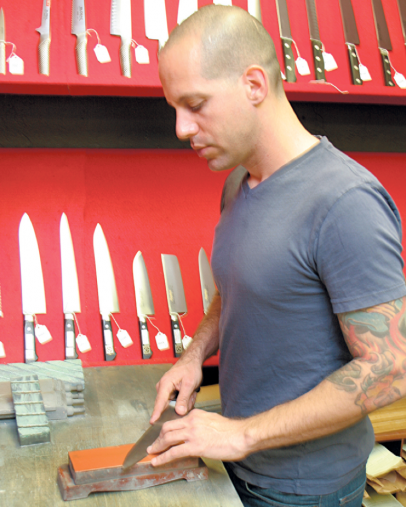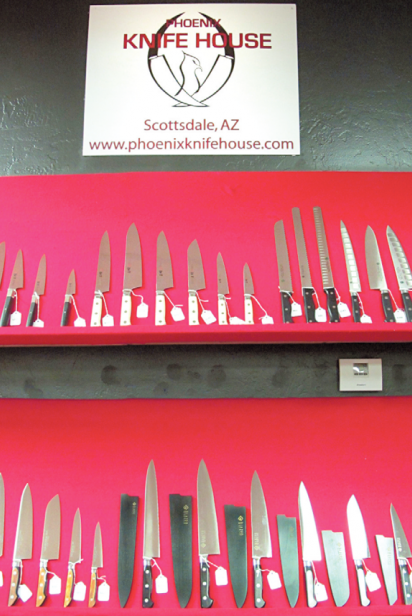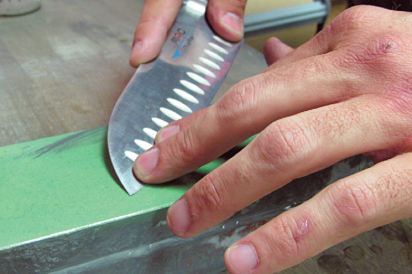The Knife Whisperer: Eytan Zias from Phoenix Knife House
His tattoos don't mean a thing, even though both arms are swirled in three-quarter sleeves of colorful ink, The logo has no deep meaning either; it's simply a literal graphic for the name of his business.
Eighty percent of his clientele wear chef pants, like he did before he traded in his starched white jackets for his current wardrobe: a gunmetal blue fitted T-shirt, baggy jeans and canvas deck shoes.
He speaks softly and his customers hang onto his every word. Ask around Valley restaurant kitchens, and they'll tell you he is the most influential guy among them.
He is Eytan Zias, the 34-year-old proprietor of Phoenix Knife House, a 4-year-old retail knife shop and knife sharpening business on McDowell Road in Scottsdale.
Zias carries more than 300 knives across 20 different brands–but you'd be hard pressed to find many German knives. He has a select few, but by and large his collection is Japanese: both Western-style Japanese knives and single-purpose traditional knives, some as pricey as $450.
The Western-style Japanese knives are displayed like fine jewelry: sparkly and just out of reach behind the counter. These knives are for those of us who fancy ourselves as serious cooks and for professionals who relish the cutting finesse of finely crafted knives.
The expensive, single-purpose knives are stashed in a corner, locked in a tall, narrow case. You'd never notice them unless, as Zias says, you were looking for them.
"If you don't know about these [traditional] knives, then you don't need them," he says.
Good point. How many of us need an unagisaki? (A specific knife for cutting eel.)
From Commercial Kitchen to Retail Storefront
Born in Israel to American parents, Zias moved to the United States when he was 20 years old, during a break in his mandatory military service, to be near family.
His first job was as a busboy at an Italian restaurant. He knew nothing about cooking, nothing about knives. He jumped to a restaurant across the street because the prep cook position sounded more interesting than bussing tables.
The chef, Willis Getchell, now a culinary instructor at Le Cordon Bleu, took a keen interest in Zias, encouraging him to enroll in Scottsdale Culinary Institute and pursue cooking as a profession. After Zias completed his Israeli military service, he returned to Scottsdale and took his mentor's advice–enrolling in culinary school in 1999.
In 2000, the fresh-faced culinary graduate never imagined that within the decade he'd give up cooking altogether and own a thriving retail and service business catering to the Valley's elite chefs. Zias was on the verge of discovering a different culinary career path, yet he didn't know it at the time.
The Japanese Way
The road to revered status for Zias began in the kitchen of Charlie Palmer's Aureole restaurant in New York, where he landed an externship in 2000, toting a brand new set of Wusthofs. When he arrived, he noticed he was the only cook with German knives. Everyone else was slicing and dicing with Japanese knives.
Zias's first Japanese knife was a Masahiro he bought at JB Prince, a knife he calls a "workhorse" and still uses. Soon after, he discovered Korin, possibly the most famous knife shop in the country.
"They have a master Japanese knife sharpener, so I started hanging out on my days off, watching the guy, learning how to sharpen by hand," he says. He was fascinated with the knives, but even more so with the sharpening process.
As Zias moved through other New York fine dining institutions (Craft, La Côte Basque and Fiamma) he accumulated a dizzying variety of Japanese knives. Then he moved back to the Valley to help open the (now closed) Scottsdale Fiamma, bringing his knife collection with him.
Logan Stephenson, now sous-chef at The Parlor, recalls Zias landing the tough fish station in the Fiamma kitchen. Stephenson, who operated the pasta station, certainly admired Zias's expert cooking skills but it was his knife kit that drew special notice.
"He had all these Japanese knives and they were amazing. They'd just dig into the cutting board–they were so sharp. You really had to know how to use them. We started asking Eytan about them and he just opened up, sharing everything he knew," Stephenson said.
As word spread, Zias was fielding questions and selling off his personal collection. It wasn't long before he started running out of knives to sell. At the same time, Zias was approaching 30, and started thinking about his life in the fast-paced cooking lane.
A Leap of Faith
"I always had a love/hate relationship with cooking. I mean, I love food, I love the action of cooking, but I didn't want to keep living that lifestyle," Zias says.
So with no solid business plan or prior retail experience, he quit cooking and opened the knife shop on borrowed money with just a handful of knives. As more chefs learned of this special knife seller/sharpener, he started selling more knives, plowing the proceeds into expanding his inventory.
His stock includes respected Japanese cutlery brands like Sugimoto and Kikuichi Wa-Gyuto. Forget that you can't pronounce these names. You also don't need to know the Japanese name for the style of knife because Zias calls them by their American names: chef 's knife, serrated knife, boning knife and paring knife.
"Eytan spends as much time with a novice as he does with a professional," Stephenson says. Zias starts the conversation with questions: "How do you cook?" and "What knives do you use now?" He selects a range of knives from the wall display and places them on the carpeted countertop, encouraging you to pick up and hold the knife.
Zias knows where each knife was made, what grade of steel (or steels) was used, how it was forged (or if it was stamp-cut from steel) and the composition of the handle. Most importantly, he knows how to sharpen it. Zias will teach anyone how to hand sharpen a knife, whether or not you purchase a knife from him.
A Gathering Place for Chefs
A well-worn red canvas couch in the middle of the brightly lit Phoenix Knife House is a hub for the professionals and fanatic home cooks who come to talk shop and ogle the knives. They watch Zias methodically, section-by-section, sharpen the tools of their trade on a series of Japanese water stones.
"It's a coffee shop for chefs," says chef and close friend Steven "Chops" Smith. "I thought I was good at sharpening until I met Eytan. He has a wealth of knowledge unlike anyone else in the business."
FnB's chef/owner Charleen Badman says, "There's really nobody like him. He knows so much about knives and sharpening," she says. "He is just as passionate about what he does as we are about what we do. We're very fortunate to have him here."
Badman bought a Misono knife from Zias last summer, giving up on the Global knives she'd used for years. She says the Misono has rarely left her hand since she bought it, other than the once-a-month trip she makes to Phoenix Knife House to have it sharpened.
Sharpest Knife in the Block
"He knows what he's doing, so he's going to take off the least amount of metal," says Badman, who acknowledges she knows how to sharpen, but still leaves the task to Zias.
A sharp knife is as important to a chef as the act of cooking itself is.
"When you slice a tomato with a sharp knife, you get a clean, glistening, juicy cut," says Smith. "Cut it with a dull knife and it's rough and jagged. You respect the food you're cooking by cutting it with the right knife with the right edge."
Not all knives need the precision of hand sharpening, and Zias says a fair amount of the sharpening he does is machine belt sharpening and polishing. Most European and Chinese knives are better suited to machine sharpening because the blades are thicker than Japanese knives, he says. Machine sharpened edges, although not as micro-sharp as those sharpened by hand, tend to last longer, too.
Smith and Stephenson hand sharpen their own Phoenix Knife House knives (both were schooled over the course of several sessions with Zias). But they still travel to the South Scottsdale store to hang out with other chefs, talk shop and watch their mentor and friend at work, sharpening knives with a steady hand and the quiet focus of a craftsman.
"He just has a knack for sharpening," Stephenson says. "It's a skill, but it's also an art."
Basic Five-Knife Set Recommendation
1. Chef's Knife (8 to 10 inches) Most important knife in the set. Will perform almost all cutting tasks such as chopping and mincing.
2. Slicer (10 inches) To slice roasts, fish and other items that are either larger or require very fine cuts. The narrow blade reduces sticking and the long length reduces strokes needed, resulting in cleaner cuts.
3. Serrated knife (8 to 10 inches) To cut bread or anything with a hard crust. A plain edge will slide over a hard surface, whereas a serrated edge will saw through crust.
4. Boning knife (6 inches) Narrow blade and tough edge, but nimble enough to work around bones without chipping. Used for deboning and trimming meats.
5. Paring knife (3 to 4 inches) Used for coring, peeling and other knife work not done on the cutting board.
Phoenix Knife House Tips on Knife Care
Proper cutting surfaces: Use only soft cutting boards such as wood, bamboo, plastic or rubber. Do not cut on hard surfaces, such as marble, glass or countertops, which will dull the knife's edge.
Storage: Blades should be protected to prevent chipping. Keep in a knife block, wood-covered wall magnet or in the original box.
Cleaning: Do not put any knife in the dishwasher, which leads to rusting, chipping and handle damage. No knife is completely stainless and must be washed by hand and immediately dried.
Honing: Use a high-grit whetstone, ceramic rod or European style "butcher's steel" or a bench strop to maintain the edge between sharpening.
Sharpening: Every knife owner should know how to sharpen their knife, but if you choose to have your knives sharpened professionally, make sure the sharpener knows how to care for your particular knife. Do not use any draw-through devices as all knives have different angles.







